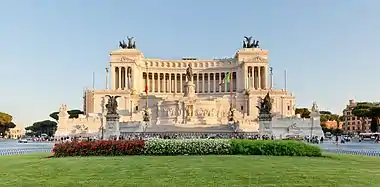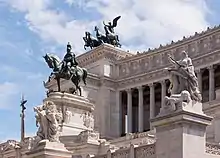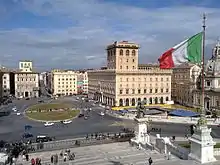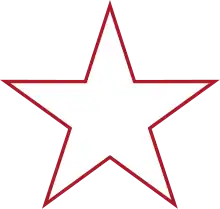National symbols of Italy
National symbols of Italy are the symbols that uniquely identify Italy reflecting its history and culture.[1] They are used to represent the Nation through emblems, metaphors, personifications, allegories, which are shared by the entire Italian people.
| Part of a series on the |
| Culture of Italy |
|---|
 |
| History |
| People |
| Languages |
| Traditions |
| Cuisine |
| Festivals |
| Religion |
| Art |
| Literature |
| Sport |
|
Some of them are official, ie they are recognized by the Italian state authorities, while others are part of the identity of the country without being defined by law.
Description

The three main official symbols,[3] whose typology is present in the symbology of all nations, are:
- the flag of Italy, that is, the national flag in green, white and red, as required by article 12 of the Constitution of the Italian Republic;[4]
- the emblem of Italy, that is the iconic symbol identifying the Italian Republic;
- The Il Canto degli Italiani by Goffredo Mameli and Michele Novaro, the Italian national anthem, which is performed in all public events.
Of these only the flag is explicitly mentioned in the Italian Constitution; this normative insertion puts the flag under the protection of the law, making it possible criminal penalties for contempt of the same.[5]
Other official symbols, as reported by the Presidency of the Italian Republic,[3] are:
- the Presidential Standard of Italy, that is the distinctive standard representing the Presidency of the Italian Republic;
- the Altare della Patria, or the national monument dedicated to King Vittorio Emanuele II of Savoy, the first Sovereign of a united Italy and founder of the Fatherland, which houses the shrine of the Italian tomb of the Unknown Soldier.
- the Festa della Repubblica, that is the national celebratory day established to commemorate the birth of the Italian Republic, which is celebrated every year on 2 June, date of the institutional referendum of 1946 with which the monarchy was abolished;
The teaching in the schools of the Il Canto degli Italiani, the reflection on the Risorgimento events and on the adoption of the Flag of Italy are prescribed by law n. 222 of 23 November 2012.[6][7]
There are also other symbols or emblems of Italy which, although not defined by law, are part of the Italian identity:
- the Italia turrita, that is the national personification of Italy in the appearance of a young woman with her head surrounded by a wall crown completed by towers (hence the term "turrita");
- the cockade of Italy, or the national ornament of Italy, obtained by folding a green, white and red ribbon into plissé using the technique called plissage ("pleating");
- the national colours of Italy are green, white, and red, collectively known in Italian as il tricolore (the tricolour). In sport in Italy, savoy azure has been used or adopted as the colour for many national teams, the first being the men's football team in 1910. The national auto racing colour of Italy is instead rosso corsa ("racing red"), while in other disciplines such as cycling and winter sports, which often use white.
- the strawberry tree, or the small tree chosen as a national tree because of its green leaves, its white flowers and its red berries, colors that recall the Italian flag;[8]
- the Stella d'Italia, the most ancient identity symbol of Italian land, since it dates back to ancient Greece.[9]
- the Frecce Tricolori, or the national aerobatic team of the Italian Air Force;
Symbols
Altare della Patria


The Vittorio Emanuele II Monument (Italian: Monumento Nazionale a Vittorio Emanuele II) or (Mole del) Vittoriano, improperly called Altare della Patria (English: Altar of the Fatherland), is a monument built in honor of Victor Emmanuel II, the first king of a unified Italy, located in Rome, Italy.[10] It occupies a site between the Piazza Venezia and the Capitoline Hill. It is currently managed by the Polo Museale del Lazio, the Italian Ministry of Defense and the Museo Centrale del Risorgimento Italiano.
From an architectural point of view it was conceived as a modern forum, an agora on three levels connected by stairways and dominated by a portico characterized by a colonnade. The complex process of national unity and liberation from foreign domination carried out by King Vittorio Emanuele II of Savoy, to whom the monument is dedicated, has a great symbolic and representative value, being architecturally and artistically centered on the Italian unification: for this reason the Vittoriano is considered one of the national symbols of Italy.[11]
It also preserves the Altar of the Fatherland (Italian: Altare della Patria), first an altar of the goddess Rome and then also a shrine of the Italian Unknown Soldier, thus adopting the function of a lay temple consecrated to Italy. Because of its great representative value, the entire Vittoriano is often erroneously called the Altare della Patria, although the latter constitutes only a part of it.
Located in the center of ancient Rome and connected to the modern one thanks to streets radiating from Piazza Venezia, it has been consecrated to a wide symbolic value representing - thanks to the call of the figure of Vittorio Emanuele II and the realization of the Altare della Patria - a lay temple metaphorically dedicated to a free and united and celebrating Italy - by virtue of the burial of the Unknown Soldier - the sacrifice for the homeland and for the connected ideals.
Cockade of Italy


The cockade of Italy (Italian: Coccarda italiana tricolore) is the national ornament of Italy, obtained by folding a green, white and red ribbon into a plissé using the technique called plissage ("pleating").[12]
It is one of the national symbols of Italy and is composed of the three colors of the Italian flag with the green in the center, the white immediately outside and the red on the edge: this convention on the position of colors derives from the cockades used in Bologna in 1794 during an attempt of revolt, which had this chromatic composition.[12] The cockade with the red and green inverted position is instead that of Iran.[13]
The Italian tricolor cockade appeared for the first time in Genoa on 21 August 1789, and with it the colors of the three Italian national colors, anticipating by seven years the first tricolor military banner, which was adopted by the Lombard Legion on 11 October 1796,[14] and of eight years the birth of the flag of Italy, which had its origins on 7 January 1797, when it became for the first time a national flag of an Italian sovereign State, the Cispadane Republic.[15] The hypotheses that consider the birth of the three Italian national colors ascribable to the medieval or Renaissance period, or linked to Freemasonry, are rejected by historians.
The green, white and red applied to a tricolor cockade reappeared during the failed uprising of Bologna against the Papal States of 13–14 November 1794 by Luigi Zamboni and Giovanni Battista De Rolandis.[16] On 14 June 1848 it replaced the azure cockade on the uniforms of some departments of the Royal Sardinian Army (become Royal Italian Army in 1861), while on 1 January 1948, with the birth of the Italian Republic, it took its place as a national ornament.[17]
The Italian tricolor cockade is one of the symbols of the Italian Air Force and one of its fabric reproductions is sewn onto the meshes of the sports teams holding the Italian Cups which are organized in various national team sports.
Emblem of Italy

The emblem of the Italian Republic (Italian: emblema della Repubblica Italiana) was formally adopted by the newly formed Italian Republic on 5 May 1948. Although often referred to as a coat of arms (or stemma in Italian), it is technically an emblem akin to so-called socialist heraldry as it was not designed to conform to traditional heraldic rules.
The emblem comprises a white five-pointed star, the Stella d'Italia, with a thin red border, superimposed upon a five-spoked cogwheel, standing between an olive branch to the left side and an oak branch to the right side; the branches are in turn bound together by a red ribbon with the inscription "REPVBBLICA ITALIANA" ("Italian Republic" written in Italian, but in an ancient Roman-style Latin alphabet). The emblem is used extensively by the Italian government.
The armorial bearings of the House of Savoy, blazoned gules a cross argent, were previously in use by the former Kingdom of Italy; the supporters, on either side a lion rampant Or, were replaced with fasci littori (literally bundles of the lictors) during the fascist era.
Festa della Repubblica

Festa della Repubblica ([ˈfɛsta della reˈpubblika]; in English, Republic Day) is the Italian National Day and Republic Day, which is celebrated on 2 June each year, with the main celebration that takes place in Rome. The Festa della Repubblica is one of the national symbols of Italy.
The day commemorates the institutional referendum held by universal suffrage in 1946, in which the Italian people were called to the polls to decide on the form of government, following the Second World War and the fall of Fascism
The ceremonial of the event organized in Rome includes the deposition of a laurel wreath as a tribute to the Unknown Soldier at the Altare della Patria by the President of the Italian Republic and a military parade along Via dei Fori Imperiali in Rome.
Flag of Italy


The flag of Italy (Italian: Bandiera d'Italia, Italian: [banˈdjɛːra diˈtaːlja]), often referred to in Italian as il Tricolore (Italian: [il trikoˈloːre]); is a tricolour featuring three equally sized vertical pales of green, white and red, with the green at the hoist side. Its current form has been in use since 18 June 1946 and was formally adopted on 1 January 1948.[18]
The Tricolour Day, Flag Day dedicated to the Italian flag, is established by law n. 671 of 31 December 1996, which is held every year on 7 January. This celebration commemorates the first official adoption of the tricolor as a national flag by a sovereign Italian state, the Cispadane Republic, which took place in Reggio Emilia on 7 January 1797. The Italian national colors appeared for the first time in Genoa on a tricolor cockade on 21 August 1789, anticipating by seven years the first green, white and red italian military war flag, which was adopted by the Lombard Legion on 11 October 1796.
Cispadana Republic supplanted Duchy of Milan after Napoleon's victorious army crossed Italy in 1796. The colours chosen by the Cispadane Republic were red and white, which were the colours of the recently conquered flag of Milan; and green, which was the colour of the uniform of the Milanese civic guard. During this time, many small French-proxy republics of Jacobin inspiration supplanted the ancient absolute Italian states and almost all, with variants of colour, used flags characterised by three bands of equal size, clearly inspired by the French model of 1790.[19]
After the date of 7 January 1797 the popular consideration for the Italian flag grew steadily, until it became one of the most important symbols of the Risorgimento, which culminated on 17 March 1861 with the proclamation of the Kingdom of Italy, of which the tricolor rose to national flag. The tricolor flag went through more than two centuries of History of Italy, greeting all the most important events.
Frecce Tricolori

The Frecce Tricolori ([ˈfrettʃe trikoˈloːri]; literally "Tricolour Arrows"), officially known as the 313° Gruppo Addestramento Acrobatico, Pattuglia Acrobatica Nazionale (PAN) Frecce Tricolori ("313th Acrobatic Training Group, National Aerobatic Team (PAN) Frecce Tricolori"), is the aerobatic demonstration team of the Italian Air Force, based at Rivolto Air Base, province of Udine, in the north-eastern Italian region of Friuli Venezia Giulia, born in 1961 following the decision of the same Air Force and to create a permanent group for the training for the collective air acrobatics of its pilots.
They were formed in 1961 as an Air Force team, replacing unofficial teams that had been sponsored by various commands by the beginning of the 1930s.[20] The team flies the Aermacchi MB-339-A/PAN, a two-seat fighter-trainer craft capable of 898 km/h at sea level.[20][21] With ten aircraft, nine in training and a soloist, they are the world's largest acrobatics patrol, and their flight schedule, comprising about twenty acrobatics and about half an hour, made them the most famous in the world.[22]
Il Canto degli Italiani

Il Canto degli Italiani (Italian pronunciation: [il ˈkanto deʎʎ itaˈljaːni];[23] "The Song of Italians") is the national anthem of Italy. It is best known among Italians as the "Inno di Mameli" ([ˈinno di maˈmɛːli], "Mameli's Hymn"), after the author of the lyrics, or "Fratelli d'Italia" ([fraˈtɛlli diˈtaːlja], "Brothers of Italy"), from its opening line.
The words were written in the autumn of 1847 in Genoa, by the then 20-year-old student and patriot Goffredo Mameli. Two months later, they were set to music in Turin by another Genoese, Michele Novaro.[24] The hymn enjoyed widespread popularity throughout the period of the Italian unification and in the following decades. Nevertheless, after the proclamation of unified Kingdom of Italy in 1861, the adopted national anthem was the "Marcia Reale" (Royal March), the official hymn of the House of Savoy composed in 1831 by order of King Charles Albert of Sardinia.
After the World War II, Italy became a republic, and on 12 October 1946, "Il Canto degli Italiani" was provisionally chosen as the country's new national anthem. It was made official on 4 December 2017 de jure.
Italia turrita

Italia turrita (pronounced [iˈtaːlja turˈriːta]; "Turreted Italy") is the national personification or allegory of Italy, in the appearance of a young woman with her head surrounded by a mural crown completed by towers (hence turrita or "with towers" in Italian). It is often accompanied by the Stella d'Italia ("Star of Italy"), from which the so-called Italia turrita e stellata ("turreted and stellate Italy"), and by other additional attributes, the most common of which is the cornucopia. The allegorical representation with the towers, which draws its origins from ancient Rome, is typical of Italian civic heraldry, so much so that the wall crown is also the symbol of the cities of Italy.
Italia turrita, which is one of the national symbols of Italy, has been widely depicted for centuries in the fields of art, politics and literature. Its most classic aspect, which derives from the primordial myth of the Great Mediterranean Mother and which was definitively specified at the turn of the 16th and 17th centuries by Cesare Ripa, wants to symbolically convey the royalty and nobility of Italian cities (thanks to the presence of crown turrita), the abundance of agricultural crops of the Italian peninsula (represented by the cornucopia) and the shining destiny of Italy (symbolized by the Stella d'Italia).
National colours of Italy

The national colours of Italy are green, white, and red, collectively known in Italian as il tricolore (the tricolour). The three Italian national colors appeared for the first time in Genoa on August 21, 1789 on the cockade of Italy shortly after the outbreak of the French Revolution. In sport in Italy, savoy azure has been used or adopted as the colour for many national teams, the first being the men's football team in 1910. The national auto racing colour of Italy is instead rosso corsa ("racing red"), while in other disciplines such as cycling and winter sports, white is often used.
Presidential Standard of Italy

The Presidential Standard of Italy (Italian: Stendardo presidenziale italiano) is the distinctive standard of the presence of the President of the Italian Republic.
Therefore, it follows the Head of State whenever he leaves the Quirinal Palace, where he is exposed during his presence.[25] The standard is displayed on the means of transport on which the president ascends, outside the prefectures when the president is visiting a city and inside the halls where he acts in an official capacity.[25] The presidential standard is one of the National symbols of Italy.
The standard recalls the colors of the flag of Italy, with particular reference to the standard of the historic Italian Republic of 1802-1805; the square shape and the savoy blue border, whose use was maintained even in the Republican era, symbolize the Italian Armed Forces, which are commanded by the president.[25]
Stella d'Italia

The Stella d'Italia ("Star of Italy"), popularly known as Stellone d'Italia ("Great Star of Italy"),[26] is a five-pointed white star symbolizing Italy for many centuries. It is the oldest national symbol of Italy, since it dates back to ancient Greece[9] when Venus, associated with the West as an evening star, was hired to identify the Italian peninsula. From an allegorical point of view, the Stella d'Italia metaphorically represents the shining destiny of Italy.[27]
In the early 16th century it began to be frequently associated with Italia turrita, the national personification of the Italian peninsula. The Stella d'Italia was adopted as part of the emblem of Italy in 1947, where it is superimposed on a steel cogwheel, all surrounded by an oak branch and an olive branch.
Strawberry tree

The strawberry tree began to be considered one the national symbols of Italy in the 19th century, during the Italian unification, because with its autumn colors it remembers the flag of Italy (green for its leaves, white for its flowers and red for its berries).[8][28] For this reason it is the national tree of Italy.
See also
Citations
- "England's National Symbols". england.org.za. Archived from the original on 24 October 2012. Retrieved 18 September 2012.
National symbols are defined as the symbols or icons of a national community (such as England), used to represent that community in a way that unites its people.
- The central subject of the print is formed by three female figures with dresses forming the flag of Italy. At the center there is a winged Victory surmounted by the Stella d'Italia and adorned with a collar bearing the Savoy coat of arms. On the left is the Italia turrita, while on the right is the warrior Rome with a Roman helmet holding a spear and a shield with the image of the Capitoline Wolf nursing Romulus and Remus. On the left is the palm of victory, while in the background we can recognize the Altare della Patria, the Equestrian Statue of Marcus Aurelius of the Capitoline Hill, the Colosseum, a Triumphal arch, the Trajan's Column, the word SPQR and a winged putto playing the ring of victory. The image is surmounted by a weave of oak and strawberry tree, while below is an aquila with spread wings in a laurel wreath.
- "I simboli della Repubblica" (in Italian). Retrieved 8 November 2017.
- [...] The flag of the Republic is the Italian tricolor: green, white and red, with three vertical bands of equal size. [...]
Article No. 12 of the Constitution of the Italian Republic of 27 December 1947, published in the 'Official Journal of the Italian Republic No. 298, Extraordinary Edition, 27 December 1947, and entered into force on 1 January 1948. - Calabrese 2011, p. 109.
- "Legge 23 novembre 2012, n. 222" (in Italian). normattiva.it. Retrieved 30 November 2014.
- "Legge 23 novembre 2012, n. 222" (in Italian). gazzettaufficiale.it. Retrieved 30 November 2014.
- "Il corbezzolo simbolo dell'Unità d'Italia. Una specie che resiste agli incendi" (in Italian). altovastese.it. Retrieved 25 January 2016.
- Rossi 2014, p. 38.
- Atkinson, David; Cosgrove, Denis (March 1998). "Urban Rhetoric and Embodied Identities: City, Nation, and Empire at the Vittorio Emanuele II Monument in Rome, 1870-1945". Annals of the Association of American Geographers. 88 (1): 28–49. doi:10.1111/1467-8306.00083.
- "I SIMBOLI DELLA REPUBBLICA - IL VITTORIANO".
- "La Coccarda alla Biblioteca Museo Risorgimento" (in Italian). Retrieved 7 May 2017.
- "Renata Polverini: coccarde tricolori alla sua giunta ma i colori sono invertiti – Il Messaggero" (in Italian). Retrieved 6 May 2017.
- "L'Esercito del primo Tricolore" (PDF) (in Italian). Archived from the original (PDF) on 9 March 2017. Retrieved 8 March 2017.
- "I simboli della Repubblica" (PDF) (in Italian). Archived from the original (PDF) on 6 October 2015. Retrieved 7 May 2017.
- "Mostra Giovan Battista De Rolandis e il Tricolore" (in Italian). Archived from the original on 1 January 2016. Retrieved 14 January 2016.
- "Le origini della bandiera italiana" (in Italian). Retrieved 14 August 2018.
- Costituzione della Repubblica Italiana Art. 12, 22 dicembre 1947, pubblicata nella Gazzetta Ufficiale n. 298 del 27 dicembre 1947 edizione straordinaria (published in the Official Gazette [of the Italian Republic] No. 298 of 27 December 1947 extraordinary edition) "La bandiera della Repubblica è il tricolore italiano: verde, bianco, e rosso, a tre bande verticali di eguali dimensioni"
- "The Italian Flag (Bandiera d'Italia)". lagazzettaitaliana.com. Retrieved 27 June 2018.
- Aeronautica Militare official site
- Caliaro 2005, p. 25
- Caliaro 2005, p. 25.
- (in Italian) DOP entry .
- "Italy – Il Canto degli Italiani/Fratelli d'Italia". NationalAnthems.me. Retrieved 24 November 2011.
- "Lo Stendardo presidenziale" (in Italian). Retrieved 22 September 2010.
- "I simboli della Repubblica – L'emblema" (in Italian). Retrieved 2 February 2016.
- Bazzano 2011, p. 7.
- (in Italian) various authors - Guida pratica agli alberi e arbusti in Italia; Biblioteca per chi ama la natura - Selezione dal Reader's Digest Milano 1983, 1991.
References
- Bazzano, Nicoletta (2011). Donna Italia. L'allegoria della Penisola dall'antichità ai giorni nostri (in Italian). Angelo Colla Editore. ISBN 978-88-96817-06-3.
- Calabrese, Michele (2011). "Il Canto degli Italiani: genesi e peripezie di un inno". Quaderni del Bobbio (in Italian). 3.
- Luigino, Caliaro (2005). "Frecce Tricolori". Pattuglie acrobatiche. Mondovì: Edizioni Gribaudo. ISBN 88-8058-873-7.
- Rossi, Girolamo (2014). Lo scudo crociato. Un simbolo medievale nella comunicazione politica del Novecento (in Italian). Armando Editore. ISBN 9788866774198.
External links
- (in Italian) Ecco alcuni simboli italiani!